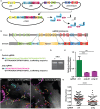Neutrophil-specific knockout demonstrates a role for mitochondria in regulating neutrophil motility in zebrafish
- PMID: 29590639
- PMCID: PMC5897731
- DOI: 10.1242/dmm.033027
Neutrophil-specific knockout demonstrates a role for mitochondria in regulating neutrophil motility in zebrafish
Abstract
Neutrophils are fast-moving cells essential for host immune functions. Although they primarily rely on glycolysis for ATP, isolated primary human neutrophils depend on mitochondrial membrane potential for chemotaxis. However, it is not known whether mitochondria regulate neutrophil motility in vivo, and the underlying molecular mechanisms remain obscure. Here, we visualized mitochondria in an interconnected network that localizes to the front and rear of migrating neutrophils using a novel transgenic zebrafish line. To disrupt mitochondrial function genetically, we established a gateway system harboring the CRISPR/Cas9 elements for tissue-specific knockout. In a transgenic line, neutrophil-specific disruption of mitochondrial DNA polymerase, polg, significantly reduced the velocity of neutrophil interstitial migration. In addition, inhibiting the mitochondrial electron transport chain or the enzymes that reduce mitochondrial reactive oxygen species also inhibited neutrophil motility. The reduced cell motility that resulted from neutrophil-specific knockout of sod1 was rescued with sod1 mRNA overexpression, or by treating with scavengers of reactive oxygen species. Together, our work has provided the first in vivo evidence that mitochondria regulate neutrophil motility, as well as tools for the functional characterization of mitochondria-related genes in neutrophils and insights into immune deficiency seen in patients with primary mitochondrial disorders.This article has an associated First Person interview with the first author of the paper.
Keywords: Cell migration; Mitochondria; Neutrophil; Tissue-specific knockout; Zebrafish.
© 2018. Published by The Company of Biologists Ltd.
Conflict of interest statement
Competing interestsThe authors declare no competing or financial interests.
Figures




Similar articles
-
A robust and flexible CRISPR/Cas9-based system for neutrophil-specific gene inactivation in zebrafish.J Cell Sci. 2021 Apr 15;134(8):jcs258574. doi: 10.1242/jcs.258574. Epub 2021 Apr 22. J Cell Sci. 2021. PMID: 33722979 Free PMC article.
-
Mitofusin 2 regulates neutrophil adhesive migration and the actin cytoskeleton.J Cell Sci. 2020 Sep 4;133(17):jcs248880. doi: 10.1242/jcs.248880. J Cell Sci. 2020. PMID: 32788232 Free PMC article.
-
The role of microtubules in neutrophil polarity and migration in live zebrafish.J Cell Sci. 2012 Dec 1;125(Pt 23):5702-10. doi: 10.1242/jcs.108324. Epub 2012 Sep 19. J Cell Sci. 2012. PMID: 22992461 Free PMC article.
-
How neutrophil metabolism affects bacterial killing.Open Biol. 2022 Nov;12(11):220248. doi: 10.1098/rsob.220248. Epub 2022 Nov 23. Open Biol. 2022. PMID: 36416011 Free PMC article. Review.
-
The Critical Role of Cell Metabolism for Essential Neutrophil Functions.Cell Physiol Biochem. 2020 Jun 27;54(4):629-647. doi: 10.33594/000000245. Cell Physiol Biochem. 2020. PMID: 32589830 Review.
Cited by
-
A robust and flexible CRISPR/Cas9-based system for neutrophil-specific gene inactivation in zebrafish.J Cell Sci. 2021 Apr 15;134(8):jcs258574. doi: 10.1242/jcs.258574. Epub 2021 Apr 22. J Cell Sci. 2021. PMID: 33722979 Free PMC article.
-
Mitofusin 2 regulates neutrophil adhesive migration and the actin cytoskeleton.J Cell Sci. 2020 Sep 4;133(17):jcs248880. doi: 10.1242/jcs.248880. J Cell Sci. 2020. PMID: 32788232 Free PMC article.
-
Immune Metabolism-An Opportunity to Better Understand Allergic Pathology and Improve Treatment of Allergic Diseases?Front Allergy. 2022 Mar 9;3:825931. doi: 10.3389/falgy.2022.825931. eCollection 2022. Front Allergy. 2022. PMID: 35386646 Free PMC article. No abstract available.
-
Mitochondria in human neutrophils mediate killing of Staphylococcus aureus.Redox Biol. 2022 Feb;49:102225. doi: 10.1016/j.redox.2021.102225. Epub 2021 Dec 24. Redox Biol. 2022. PMID: 34959099 Free PMC article.
-
Functional implications of neutrophil metabolism during ischemic tissue repair.Curr Opin Pharmacol. 2022 Apr;63:102191. doi: 10.1016/j.coph.2022.102191. Epub 2022 Mar 8. Curr Opin Pharmacol. 2022. PMID: 35276496 Free PMC article. Review.
References
Publication types
MeSH terms
Substances
Grants and funding
LinkOut - more resources
Full Text Sources
Other Literature Sources
Molecular Biology Databases
Research Materials
Miscellaneous

